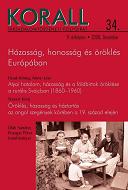„Helybeliek” és „idegenek”. Községi illetőség Torna megyében az 1869. évi népszámlálás háztartási lajstromai alapján
„Residents” and „Strangers”. Communal Domicile in Torna County on the Basis of the 1869 Census Registers
Author(s): Péter Pozsgai Subject(s): History
Published by: KORALL Társadalomtörténeti Egyesület
Summary/Abstract: The preserved nominal documentations of the mid-19th century censuses are the most important out of the archive sources of Torna county: the listings of the 1850 and 1857 “Austrian” censuses and the house-registers of the 1869 census which was executed by the Hungarian statistical office. The registers of the censuses of 1857 and 1869 indicate the names of the family-members and each co-residing members of the house who were present at the moment of the census. The register consisted of the house-number, the numbers of the households, the names and gender of the members of households, the year of birth, the religious denomination of the members of the household, the occupation and columns for presence and absence. The 1869 census included additional questions about the domicile (resident/stranger), birthplace and literacy. The censuses listed the number of domestic animals house by house, besides in 1869 all the economic buildings belonged to each house were conscribed. This article presents the additional findings of a regional historical-demographic research project. In addition to a critical analysis of the different sources and presentation of the methodology used for the research, it also presents a few conclusions based on the investigation of rural migration, migratory routes and migration networks. The source-critique should have been extended not only for the data-correction of sources and the shortages or mistakes of census-data produced by the census-takers, but for the critical analysis of the occupational terms and the household unit (‘co-resident party’) as well, since for the establishment of the consistency of the source-group and for the reliable comparative analysis a “common denominator” should have been found among the “interpretations” and different use of concepts of the census-takers which differed from each other (slightly or considerably) in the majority of the settlements. On the basis of the number of the residents and non-residents (“strangers”) determined from the census registers the proportion of migration cannot be reliably revealed, since the practice and classification of domicile from the part of the census-takers showed huge variations in the majority of settlements. Another possible way for studying the migration was to examine the population by the distribution of birthplaces. The advantage of the 1869 census that the birthplace of all the registered persons was indicated. In this analysis, however, the author deals primarily with the sources of inaccuracy in the 1869 censuses and the examination of the absent resident and the present non-resident (“strangers”) population.
Journal: Korall - Társadalomtörténeti folyóirat
- Issue Year: 2008
- Issue No: 34
- Page Range: 68-101
- Page Count: 34
- Language: Hungarian

